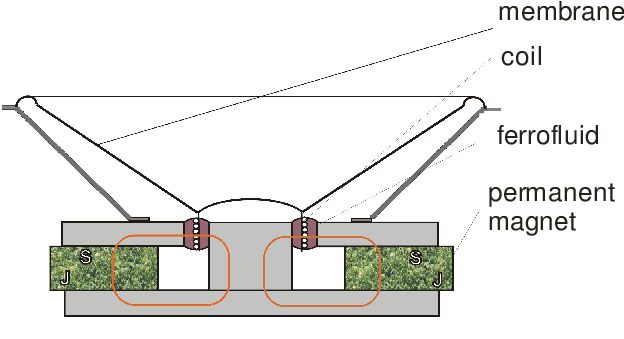Loudspeaker considerations in very cold enviroments
Many of Biamp's outdoor speaker systems in the W, R, Desono D and E series use Ferrofluid in their voice coil gaps. When used in applications below -4° C / 25° F, some special considerations should be given due to how Ferrofluid reacts at lower temperatures.
Ferrofluid basics
Ferrofluid is a viscous, oil based liquid with iron oxide particles suspended in it. The iron oxide particles help keep the fluid in the voice coil gap due to the magnetic field present.
The primary benefit of using Ferrofluid is to provide an efficient thermal path from the voice coil to the magnet structure which aids in cooling by using the magnet structure as a heat sink. Ferrofluid provides about four times the heat transfer from voice coil to magnet structure as air does.
In short, providing an efficient thermal path for the heat from the voice coil to the magnet structure will keep the voice coil cooler and reduce the effects of power compression due to the rising temperature / electrical resistance of the voice coil.
Ferrofluid provides other benefits such as mechanical damping for midrange and high frequency drivers and also retards voice coil gap corrosion in hostile operating environments.

Low temperature considerations
Since Ferrofluid is primarily oil, it's viscosity increases when it gets cold. When oil becomes more viscous it does not flow as freely and the voice coil cannot move as freely to produce sound.
The Ferrofluid formulations we use generally freely flow (have a low viscosity) down to about -4° C / 25° F. Below this temperature, the viscosity gradually increases. Once the temperature drops to about -12° C / 10° F the viscosity increases to a point where the voice coil does not travel freely and components can exhibit much lower acoustical output.
The higher viscosity does not allow smaller voice coils to move as efficiently within the thicker oil. Larger (12") woofers are less affected.
Speaker systems may be used for voice or music in a number of cold environments such as sports stadiums and outdoor facilities, ski resorts, warehouse coolers, freezers etc.
Depending on the operating temperature and duty cycle, it may be advisable to keep the voice coils warm with a stimulus signal. The type and level of the signal depend on the product and application.
Some environments (such as a ski slope) may tolerate low level, broadband noise being applied to speakers on a slope. In a warehouse freezer, we may be able to do the same so that when needed for paging the speaker will operate as intended. For a sports field it may be desirable to slowly "warm up" the speaker prior to an event during cold months.
Please contact the Loudspeaker Solutions Group to discuss your specific application and we will be happy to provide our suggestions.

